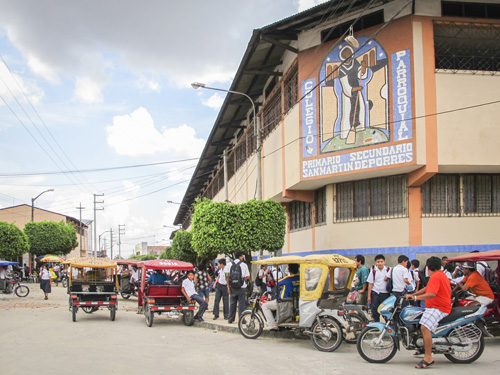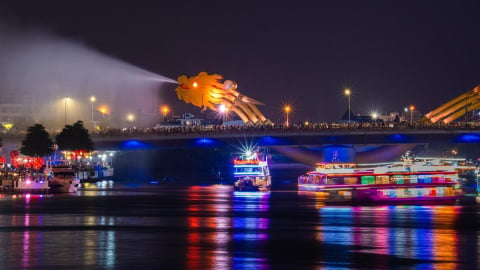The common answer is the Amazon, the world's greatest tropical natural museum, spanning nine countries, with the world's longest and largest river.

Motorcycles and moto-kars are the main means of transportation in Iquios
Having experienced moments of feeling faint from thirst and the terrible heat during the days of riding camels and wandering in the Gobi desert; moments of feeling dizzy and wanting to collapse from lack of oxygen on the peaks of passes over 5,000 m in Tibet; days of going to the fields and hunting animals in the forest with the Si La people (one of the smallest ethnic groups in Vietnam) in the Northwest mountainous region... but for me, exploring the Amazon jungle and meeting the indigenous people is always a desire even though I know that it is a challenging trip.
The “exercises” of carrying a backpack of nearly 30 kg and walking for several hours, survival skills, stargazing, direction finding… were brought out to practice again a few months before leaving. Even though I had been in Peru for 2 months (in 2008) when writing a series of travelogues about the Incas, when the consul at the Peruvian embassy knew I was going to the Amazon, he still asked for a yellow fever vaccination book and a series of other vaccines such as cholera, malaria… before agreeing to grant a visa. “For your safety. When going to the Amazon, no preparation is too much,” the consul showed me a passport with a brand new Peruvian visa stamp and smiled: “Have a safe trip.”
Iquitos- ecological capital
Located near the border of Colombia and Brazil, known as the ecological capital of the Amazon, Iquitos (a city in Peru) is isolated from the outside world by dense forests and large rivers. To get to Iquitos, you can only go by air or by water (about 4, 5 days). This is the largest city in the world that cannot be reached by road.
It takes nearly two hours to fly from Lima (the capital of Peru) to Iquitos. Same country, but just now I was still wrapped in warm clothes, wrapped in a scarf and coughing from the cold, less than two hours after getting off the plane, the heat rushed in. 36 degrees Celsius, 90% humidity. The wind blew fiercely but I was still sticky and uncomfortable.
Discovered in the mid-18th century, Iquitos was then just a small city hidden in the jungle. From the beginning of the 20th century, when the rubber fever (which was abundant in the Amazon) exploded, Iquitos became one of the busiest cities in South America. Located right on the Amazon River, Iquitos became a trading center for Europeans and Amazonians.

Wild animals sold openly at Belen market (Iquitos) - Photo: Nguyen Tap
Then the rubber fever passed (because synthetic rubber was invented and Europeans were able to “buy” rubber plantations in Asian countries), as if just waking up from a dream, Iquitos returned to its poverty. The bustling trading port of foreign ships now had only small boats exchanging and selling fruits and products of the local residents. The once prosperous and prosperous time was only remembered by the old, aging architectural works that still exist today around the central square.
I took a moto-kar (a motorcycle with a passenger compartment similar to a pedicab) with a few foreign tourists to start exploring the city. While most South American countries use cars, in Iquitos most people use motorbikes (mostly old models) that emit a lot of smoke. The drivers
The moto-kars were fast and maneuvered skillfully. As a Vietnamese, it was not strange to me, but for foreigners, it was an interesting experience. They screamed, some covered their eyes in fear.
Iquitos people are still poor, many areas have no electricity or clean water. On street corners, every evening, housewives gather to chat. Naked children chase each other around, and when TV shows come on, they gather on chairs to watch together on an old domestic TV. Here, TV, telephones, and internet are not very popular. The 3G USB bought in the capital Lima was advertised as being able to be used anywhere, but when I got here, it didn't work. I lost 200 soles (about 1.4 million VND).
The purpose of my trip this time was to meet the Matsés tribe - warriors hidden deep in the jungle, famous for kidnapping women of other tribes to be their wives and eat them. A local tour guide heard that and immediately said: "Why go far? Right here, there are the Bora and Yagua tribes, which are very interesting. Many newspapers and radio stations have come there to write articles and film." To prove it, he showed me a series of photos of bare-chested natives (including women), painted faces and striped people holding blowguns (a type of Amazonian weapon used to hunt animals). "Oh, how fascinating!", I decided immediately. Yes, let's go...
The Amazon rainforest covers 5.5 million square kilometers, spanning nine South American countries (Brazil, Peru, Colombia, Venezuela, Ecuador, Bolivia, Guyana, Surinam and French Guyana). The Amazon rainforest accounts for more than 50% of the world's rainforests with more than two and a half million insect species and tens of thousands of plant and animal species. The Amazon is also famous for its ferocious animals such as giant anacondas, poisonous frogs, piranhas, etc.


































